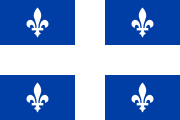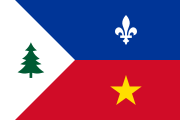The Fleur-de-lis is the "Flower of Light". It represents Mary Magdalene. Recall the lily flower that emanated light in the movie "Tangled" (Rapunzel). Her and Jesus migrated to southern France to live among the Cathars. It has been suggested that Christ's bloodline was passed down through the royal monarchy of France. France's flags have often had the Fleur-de-lis symbol on them. As fate goes, I was given a pair of Fleur-de-lis earrings as a child by relatives of mine.
Fleur-de-lis
From Wikipedia, the free encyclopedia
For other uses, see Fleur-de-lis (disambiguation).
The fleur-de-lis or fleur-de-lys (plural: fleurs-de-lis)[pron 1] is a stylized lily (in French, fleur means flower, and lis means lily) or iris that is used as a decorative design or symbol. It may be "at one and the same time, religious, political, dynastic, artistic, emblematic, and symbolic", especially in French heraldry.[4] It is represented in Unicode at U+269C (⚜) in the Miscellaneous Symbols block.Contents |
Usages
While the fleur-de-lis has appeared on countless European coats of arms and flags over the centuries, it is particularly associated with the French monarchy in a historical context, and continues to appear in the arms of the King of Spain and the Grand Duke of Luxembourg and members of the House of Bourbon. It remains an enduring symbol of France that appears on French postage stamps, although it has never been adopted officially by any of the French republics. According to French historian Georges Duby, the three leaves represent the medieval social classes: those who worked, those who fought and those who prayed.[5]In France it is widely used in city emblems like in the coat of arms of the city of Lille, Saint-Denis, Brest, Clermont-Ferrand, Boulogne-Billancourt and Calais. Some cities that had been particularly faithful to the Crown were awarded an heraldic augmentation of two or three fleurs-de-lis on the chief of their coat of arms; such cities include Paris, Lyon, Toulouse, Bordeaux, Reims, Le Havre, Angers, Le Mans, Aix-en-Provence, Tours, Limoges, Amiens, Orléans, Rouen, Argenteuil, Poitiers, Chartres and Laon among others. The fleur-de-lis was the symbol of Île-de-France, the core of the French kingdom. It appeared on the coat-of-arms of other historical provinces of France, like Burgundy, Anjou, Picardy, Berry, Orléanais, Bourbonnais, Maine, Touraine, Artois, Dauphiné, Saintonge and the County of La Marche. Many of the current departments uses the ancient symbol on its coat to express this heritage.
In Florentine fleurs-de-lis,[f] the stamens are always posed between the petals. This heraldic charge is often known as the Florentine lily to distinguish it from the conventional design. As an emblem of the city, it is therefore found in icons of the bishop Zenobius.[6] The currency of Florence, the fiorino, was decorated with it, and it influenced the appearance and name of the Hungarian forint and other florins. The Tuscan towns of Firenzuola and Castelfiorentino inherited the red Florentine lily on their coat.
The heraldic fleur-de-lis is still widespread: among the numerous cities which use it as a symbol are some whose names echo the word 'lily', for example, Liljendal, Finland. This is called canting arms in heraldic terminology. The Swiss municipality of Schlieren also has a fleur-de-lis on its coat.
In the United Kingdom, a fleur-de-lis has appeared in the official arms of the Norroy King of Arms for hundreds of years.
In Mauritius, slaves were branded with a fleur-de-lis.
The Welsh poet Hedd Wyn used Fleur de Lys as his pen name when he won his chair at the National Eisteddfod of Wales (Eisteddfod Genedlaethol Cymru), the national poetry contest.
Fleurs-de-lis appear on military insignia and the logos of many organizations. During the 20th century the symbol was adopted by various Scouting organizations worldwide for their badges. Architects and designers use it alone and as a repeated motif in a wide range of contexts, from ironwork to bookbinding, especially where a French context is implied.
The symbol is also often used on a compass rose to mark the north direction, a tradition started by Flavio Gioja, a Neapolitan mariner of the 14th century.
Earliest usage
In French, fleur de lis literally means "lily flower". It is widely thought to be a stylized version of the species Iris pseudacorus. Decorative ornaments that resemble the fleur-de-lis have appeared in artwork from the earliest human civilizations. According to Pierre-Augustin Boissier de Sauvages, an 18th century French naturalist and lexicographer:[11]"The old fleurs-de-lis, especially the ones found in our first kings' sceptres, have a lot less in common with ordinary lilies than the flowers called flambas [in Occitan], or irises, from which the name of our own fleur-de-lis may derive. What gives some colour of truth to this hypothesis that we already put forth, is the fact that the French or Franks, before entering Gaul itself, lived for a long time around the river named Luts in the Netherlands. Nowadays, this river is still bordered with an exceptional number of irises —as many plants grow for centuries in the same places—: these irises have yellow flowers, which is not a typical feature of lilies but fleurs-de-lis. It was thus understandable that our kings, having to choose a symbolic image for what later became a coat of arms, set their minds on the iris, a flower that was common around their homes, and is also as beautiful as it was remarkable. They called it, in short, the fleur-de-lis, instead of the flower of the river of lis. This flower, or iris, looks like our fleur-de-lis not just because of its yellow colour but also because of its shape: of the six petals, or leaves, that it has, three of them are alternatively straight and meet at their tops. The other three on the opposite, bend down so that the middle one seems to make one with the stalk and only the two ones facing out from left and right can clearly be seen, which is again similar with our fleurs-de-lis, that is to say exclusively the one from the river Luts whose white petals bend down too when the flower blooms."Sauvages' hypothesis seems to be supported by the archaic English spelling fleur-de-luce[12] and by the Luts's variant name Lits.
Another (debated) hypothesis is that the symbol derives from the Frankish Angon. The angon, or sting, was a typical Frankish throwing spear. A possibly derived symbol of Frankish royalty was the bee, as found in the burial of Childric I. A 9th century mosaic, from San Giovanni church in Rome, shows St Peter handing the Oriflamme, the imperial banner, to Charlemagne. The finial of the oriflamme is clearly a spearhead and very like the earliest depictions of the fleur-de-lis, on the seals of Robert II (around 1000 AD) and Phillip II (around 1180 AD).
Also of note is that the red and green circles on the oriflamme are often said to depict.....flowers. Whereby a fleur de luce becomes flower of light, where light might allude to the little golden flames that give the banner its name. A conflation, over time, of the lance, the flowers and the flames with the conserved spearhead, used as a sceptre, seems altogether more likely than the symbol of royalty of France deriving from a flower growing near an obscure little river in Frisia.
Royal symbol

Charlemagne, by Albrecht Dürer, the anachronistic coat-of-arms above him show the German eagle and the French Fleur-de-lis.
Frankish to the French monarchy
The graphic evolution of crita to fleur-de-lis was accompanied by textual allegory. By the late 13th century, an allegorical poem by Guillaume de Nangis (d. 1300), written at the abbey of Joyenval at Chambourcy, relates how the golden lilies on an azure ground were miraculously substituted for the crescents on Clovis' shield, a projection into the past of contemporary images of heraldry. Through this propagandist connection to Clovis, the fleur-de-lis has been taken in retrospect to symbolize all the Christian Frankish kings, most notably Charlemagne.In the 14th century French writers asserted that the monarchy of France, which developed from the Kingdom of the West Franks, could trace its heritage back to the divine gift of royal arms received by Clovis. This story has remained popular, even though scepticism started in the 17th century and modern scholarship has established that the fleur-de-lis was a religious symbol before it was a true heraldic symbol.[15] Along with true lilies, it was associated with the Virgin Mary, and in the 12th century Louis VI and Louis VII started to use the emblem, on sceptres for example, so connecting their rulership with this symbol of saintliness. Louis VII ordered the use of fleur-de-lis clothing in his son Philip's coronation in 1179,[16] while the first visual evidence of clearly heraldic use dates from 1211: a seal showing the future Louis VIII and his shield strewn with the "flowers".[17] Until the late 14th century the French royal coat of arms was Azure semé-de-lis Or (a blue shield "sown" (semé) with a scattering of small golden fleurs-de-lis), but Charles V of France changed the design from an all-over scattering to a group of three in about 1376.[a][b] These two coats are known in heraldic terminology as France Ancient and France Modern respectively.
In the reign of King Louis IX (St. Louis) the three petals of the flower were said to represent faith, wisdom and chivalry, and to be a sign of divine favour bestowed on France.[18] During the next century, the 14th, the tradition of Trinity symbolism was established in France, and then spread elsewhere.
In 1328, King Edward III of England inherited a claim to the crown of France, and in about 1340 he quartered France Ancient with the arms of Plantagenet, as "arms of pretence". [c] After the kings of France adopted France Modern, the kings of England adopted the new design as quarterings from about 1411.[19] The monarchs of England (and later of Great Britain) continued to quarter the French arms until 1801, when George III abandoned his formal claim to the French throne.
King Charles VII ennobled Joan of Arc's family on 29 December 1429 with an inheritable symbolic denomination. The Chamber of Accounts in France registered the family's designation to nobility on 20 January 1430. The grant permitted the family to change their surname to du Lys.
France Modern
France Modern remained the French royal standard, and with a white background was the French national flag until the French Revolution, when it was replaced by the tricolor of modern-day France. The fleur-de-lis was restored to the French flag in 1814, but replaced once again after the revolution against Charles X of France in 1830.[d] In a very strange turn of events after the end of the Second French Empire, where a flag apparently influenced the course of history, Henri, comte de Chambord, was offered the throne as King of France, but he agreed only if French gave up the tricolor and bring back the white flag with fleurs-de-lis.[20] His condition was rejected and France became a republic.Other European monarchs and rulers
The tressure flory-counterflory (flowered border) has been a prominent part of the design of the Scottish royal arms and Royal Standard since James I of Scotland.[e]
In Italy, fleurs-de-lis have been used for some papal crowns[g] and coats of arms, the Farnese Dukes of Parma, and by some doges of Venice.The treasured fleur-de-luce he claims
To wreathe his shield, since royal James
The fleur-de-lis was also the symbol of the House of Kotromanić, a ruling house in medieval Bosnia allegedly in recognition of the Angevin, where the flower is thought of as a Lilium bosniacum. [h] Today, fleur-de-lis is a national symbol of Bosniaks,[i] one of three Bosnian constitutive ethnic groups, the other two being Serbs and Croats.
Other countries using the emblem heraldically include Serbia and Spain in recognition of rulers from the House of Bourbon. Coins minted in 14th century Romania, from the region that was the Principality of Moldova at the time, ruled by Petru I Mușat, carry the fleur-de-lis symbol ([22]).
As a dynastic emblem it has also been very widely used: not only by noble families but also, for example, by the Fuggers, a medieval banking family.
Other continents
The fleur-de-lis appears on the Canadian coat of arms, the flag of Quebec[j] and also those of Montreal, Sherbrooke and Trois-Rivières. The Queen of Canada's personal flag also features it. There are many French-speaking people in other Canadian provinces for whom the fleur-de-lis remains a symbol of their cultural identity. Franco-Ontarians, for example, feature the fleur-de-lis prominently on their flag.
In the US, they fleur-de-lis symbols tend to be along or near the Mississippi and Missouri rivers. Some of the places that have it in their flag or seal are the cities of St. Louis[m], Louisville, Detroit, Mobile, New Orleans, Baton Rouge and Lafayette. On 9 July 2008, Louisiana governor Bobby Jindal signed a bill into law making the fleur-de-lis an official symbol of the state.[23] Following Hurricane Katrina, the fleur-de-lis has been widely used in New Orleans as a symbol of grassroots support for New Orleans' recovery.[24]
The fleur-de-lis appears on the coat of Guadeloupe, an overseas département of France in the Caribbean, Saint Barthélemy, an overseas collectivity of France, and French Guiana. The overseas department of Réunion in the Indian Ocean uses the same feature. It appears on the coat of Port Louis, the capital of Mauritius which was named in honour of King Louis XV. On the coat of arms of Saint Lucia it represents the French heritage of the country.
In Saskatchewan the Western Red Lily appears on the provincial flag and is sometimes used as a symbol of the province. Some representations resemble a fleur de lis but the traditional version itself is rarely used.
Coats of arms and flags
|
Symbolism in religion and art
In the Middle Ages the symbols of lily and fleur-de-lis (lis is French for "lily") overlapped considerably in Christian religious art. Michel Pastoureau, the historian, says that until about 1300 they were found in depictions of Jesus, but gradually they took on Marian symbolism and were associated with the Song of Solomon's "lily among thorns" (lilium inter spinas), understood as a reference to Mary. Other scripture and religious literature in which the lily symbolizes purity and chastity also helped establish the flower as an iconographic attribute of the Virgin. It was also believed that the fleur-de-lis represented the Holy Trinity.[25][26]In medieval England, from the mid-12th century, a noblewoman's seal often showed the lady with a fleur-de-lis, drawing on the Marian connotations of "female virtue and spirituality".[27] Images of Mary holding the flower first appeared in the 11th century on coins issued by cathedrals dedicated to her, and next on the seals of cathedral chapters, starting with Notre Dame de Paris in 1146. A standard portrayal was of Mary carrying the flower in her right hand, just as she is shown in that church's Virgin of Paris statue (with lily), and in the centre of the stained glass rose window (with fleur-de-lis sceptre) above its main entrance. The flowers may be "simple fleurons, sometimes garden lilies, sometimes genuine heraldic fleurs-de-lis".[17] As attributes of the Madonna, they are often seen in pictures of the Annunciation, notably in those of Sandro Botticelli and Filippo Lippi. Lippi also uses both flowers in other related contexts: for instance, in his Madonna in the Forest.
The three petals of the heraldic design reflect a widespread association with the Holy Trinity, with the band on the bottom symbolizing Mary. The tradition says that without Mary you can not understand the Trinity since it was she who bore The Son.[28] A tradition going back to 14th century France[13] added onto the earlier belief that they also represented faith, wisdom and chivalry.
"Flower of light" symbolism has sometimes been understood from the archaic variant fleur-de-luce (see Latin lux, luc- = "light"), but the Oxford English Dictionary suggests this arose from the spelling, not from the etymology.[29]
Architecture
Modern usage
- Also see North America section above.
The symbol may be used in less traditional ways. After Hurricane Katrina many New Orleanians of varying ages and backgrounds were tattooed with "one of its cultural emblems" as a "memorial" of the storm, according to a researcher at Tulane University.[33] The US Navy Blue Angels have named a looping flight demonstration manoeuvre after the flower as well, and there are even two surgical procedures called "after the fleur."
Owing to its French heritage, Chevrolet has used the fleur-de-lis emblems on their cars, most notably the Corvette, but until 1990, the Caprice sedan.
The current UFC Welterweight Champion, Georges St. Pierre, has a tattoo of the fleur-de-lis on his right calf.
The Campbells soup company uses it on its soup can labels.
New Orleans based metal band Down use the symbol frequently on t shirt designs and it features on their album Nola.
Symbol of Scouting
Main article: Fleur-de-lis in Scouting
The fleur-de-lis is the main element in the logo of most Scouting
organizations, representing a major theme in Scouting: the outdoors and
wilderness. The World Scout Emblem of the World Organization of the Scout Movement, has elements of which are used by most national Scout organizations. The symbol was chosen by Sir Robert Baden-Powell as it had been the arm-badge of those soldiers qualified as "Scouts" (reconnaissance specialists) when he served in the British Army.
The classical description of this shape in Scouting literature connects
the compass rose with the purpose of Scouting's principles—namely that
Scouting gives one's life direction. The stars stand for truth and
knowledge, the encircling rope for unity, and its reef knot, service.[34]In literature
The symbol has featured in modern fiction on historical and mystical themes, as in the bestselling novel The Da Vinci Code and other books discussing the Priory of Sion. It recurs in French literature, where examples well known in English translation include Fleur-de-Lys de Gondelaurier, a character in The Hunchback of Notre Dame by Victor Hugo, and the mention in Dumas's The Three Musketeers of the old custom of branding a criminal with the sign (fleurdeliser). During the reign of Elizabeth I of England, known as the Elizabethan era, it was a standard name for an iris, a usage which lasted for centuries,[35] but occasionally refers to lilies or other flowers. It also appeared in the novel A Confederacy of Dunces by John Kennedy Toole on a sign composed by the main character.- The lilly, Ladie of the flowring field,
- The Flowre-deluce, her louely Paramoure
In media
- In the first three seasons of the television series Weeds, a fleur-de-lis is the emblem of the housing development Agrestic.
- In the "Warhammer 40,000" universe, the fleur-de-lis is the symbol of the Sisters of Battle.
- In Saint's Row, the fleur-de-lis is the symbol of the Third Street Saints street gang.
- In The Da Vinci Code, the fleur-de-lis represents the Priory of Sion.
- For a substantial period of time during their career, the fleur-de-lis was a symbol of Finnish Power Metal band Stratovarius.
See also
Notes
- ^ Pronounced /ˈflɜr də ˈliːs/ or /ˈflɜr də ˈliː/; French: [flœʁ də lis]. The Oxford English Dictionary gives both pronunciations for English. In French, Larousse[1] and Robert[2] have the former: [lis]. The CNRTL[3] has that pronunciation for the plant itself, but, following Barbeau-Rodhe 1930, [li] for the compound fleur-de-lis






































No comments:
Post a Comment
Note: Only a member of this blog may post a comment.